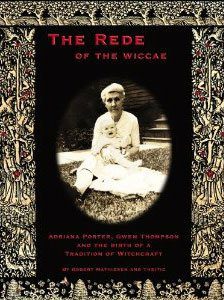 In The Rede of the Wiccae, Robert Mathiesen, a medieval philologist, and Theitic, an initiate and elder, come together to examine one of the Craft’s well-known grandmother tales. It is the story told by Lady Gwen Thompson about her grandmother, Adriana Porter, and how she became the last carrier of an ancestral tradition of Witchcraft.
In The Rede of the Wiccae, Robert Mathiesen, a medieval philologist, and Theitic, an initiate and elder, come together to examine one of the Craft’s well-known grandmother tales. It is the story told by Lady Gwen Thompson about her grandmother, Adriana Porter, and how she became the last carrier of an ancestral tradition of Witchcraft.
The story goes that Lady Gwen inherited a tradition of family Witchcraft from her grandmother. She intended to keep the tradition in the family, but her son converted to Christianity and her daughter didn’t have children. Fearing the tradition would be lost, Lady Gwen began teaching and initiating. Her covens came to be known as the New England Covens of Traditionalist Witches.
The authors begin by examining the facts of Lady Gwen’s ancestry. There is a great amount of genealogical records regarding the family dating back to their emigration from England to Massachusetts on the Mayflower in 1620. A large chunk of the book is devoted to genealogy, dates, places, and relationships.
Over the years, Lady Gwen’s ancestors settled in various spots from Massachusetts to Nova Scotia. Some of them were of modest means and some of them were very wealthy and politically influential. Some of them were Puritans. Some were accusers and defenders during the Salem Witch Trials (never the accused). Others still were involved in various esoteric activities that waxed and waned in popularity over the years such as Rosicrucianism, Theosophy, and spiritualism.
The authors take a closer look at the single piece of text that Lady Gwen ever published, the Rede of the Wiccae, which appeared in Green Egg magazine in 1975. Lady Gwen claimed this 26-line poem was passed down to her from her grandmother, but the Rede seems very familiar to that of Doreen Valiente’s. The authors look at the language and structure and analyse the sources to determine the origin of the Rede.
Mathiesen and Theitic make a compelling argument in support of Lady Gwen’s story, but there are problems. There is little to independently support Lady Gwen’s claims. She herself admitted that she destroyed the original version of her grandmother’s book of lore after copying its contents. She recopied her own book several times throughout her lifetime. The Rede is suspect for several reasons including that Porter died in 1946 and the Rede refers to Wiccan concepts yet unknown. Lady Gwen published it in 1975, more than a decade after Doreen Valiente gave a speech that contained those now famous words, “Eight words the Wiccan Rede fulfill, An’ it harm none, do what ye will”. The rest of Lady Gwen’s material remains oath-bound and unavailable for study by non-initiates, making it impossible to come to any solid conclusion.
This is not a book for everyone. It’s full of extensive genealogical information and doesn’t make for a particularly exciting read. There is next to nothing here about Lady Gwen’s lore and practices, the people she worked with, her influence, or even the Craft in general. The authors assume readers know who Lady Gwen is and how she influenced American Wicca. The Rede of the Wiccae is for intermediate to advanced students and practitioners. If you want to know more and dig deeper into the history of American Craft, then this book is a must.
